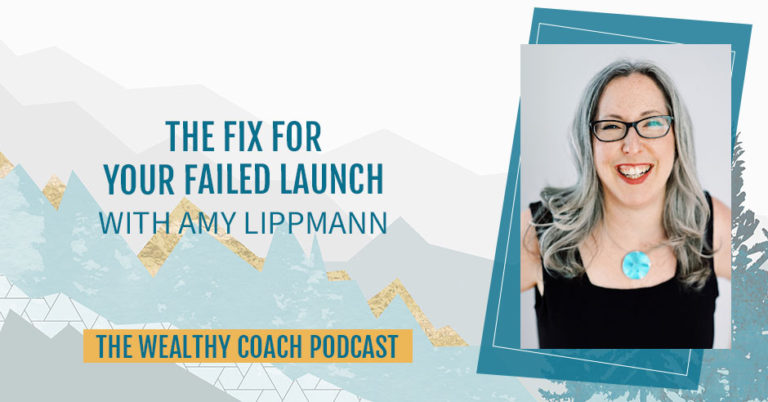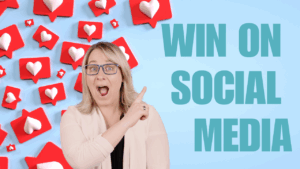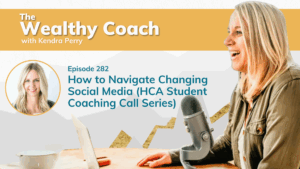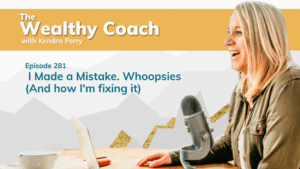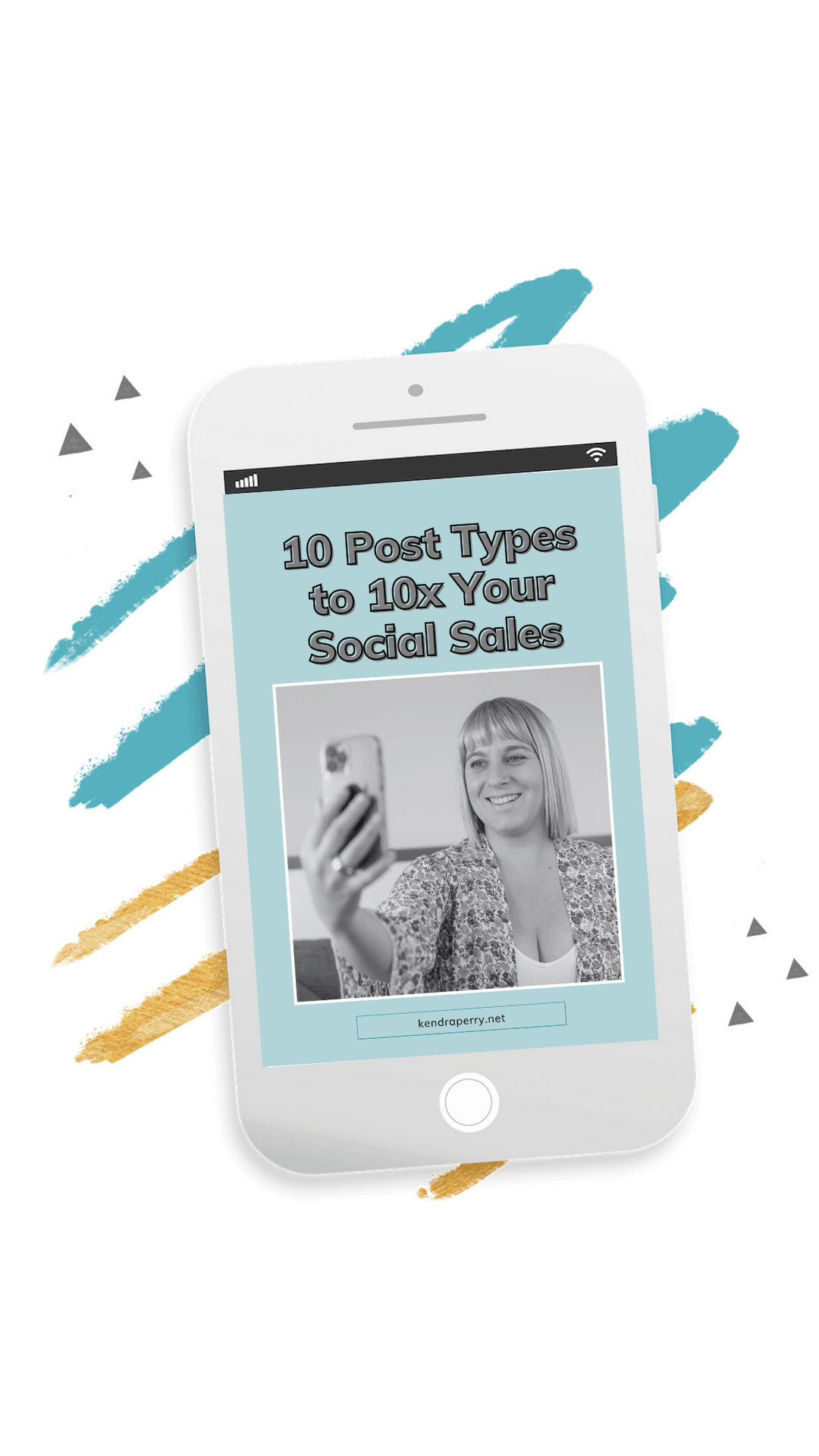Failure can be frustrating, especially if we anticipate a perfect launch. If you want to learn how to launch better or fix a failure, this episode is for you! In this episode, Amy Lippmann, a marketing strategist and launch expert, discusses how you can launch better and how to fix your failed launch. There are different types of things that you should consider when launching, and she mentioned having a short group program acting as a feeder for your private coaching program. With that in mind, putting a strategy in place can make a successful feeder which others may want to anticipate on launching your product. Learn a great deal from the expertise of a marketing strategist, and tune in to this episode today!
Download Amy’s Free Launch Guide: https://launchwithamy.com/
Connect with Amy on Social:
Facebook: https://www.facebook.com/marketingforhealthcoaches
Website: https://launchwithamy.com/
—
Listen to the podcast here
The FIX For Your Failed Launch With Amy Lippmann
I’m pumped because we are talking about one of my favorite topics. We are talking about launching. I love launching. I have a love-hate relationship with launching. I find launching fun and exciting. It’s always fun to get something out into the world, make money, and change lives. I invited a launch expert onto our show to talk all about how to launch better and fix a failed launch.
When your launch fails or you don’t hit your goals, it sucks. I have been there many times. We are going to be talking with Amy Lippmann. Amy is a marketing strategist and launch expert. She’s spent over fifteen years in the coaching industry helping thousands of coaches with their launches while banking over 50 of her own 5 and 6-figure launches. One of Amy’s greatest joys is helping coaches to launch their courses and programs into the world in a way that works best for them. Are you ready to talk about launching? Yes. Let’s do it.
—
Amy, welcome to the show.
I’m glad to be here.
I am pumped. We are talking about launching one of my favorite topics. I know that my audience is curious, and a lot of them are relatively new and are planning their first launch or considering their first launch. I would love to know how did you become a launch expert.
My journey started as a health coach. I was a health coach for five years and worked with clients one-on-one during that time. I did create a launch a group program during that time. I then transitioned. The next leg of my journey was helping health coaches and nutritionists with their businesses. Most of what I was doing during that time was helping them launch group programs. I gained a lot of experience through working with them.
At that time, I worked mostly one-on-one with the health coaches and nutritionists. I started creating my one-to-many offerings and had my launches. I’ve done much every style of launch there is, from webinars to challenges to email promotions and waiting list launches. I have two arms to my business, Marketing for Health Coaches, which focuses on working with health coaches. Also, I have Launched with Amy, which is focused on helping coaches of all kinds with launching their programs.
I’m curious. When you first started launching, did your launches always go smoothly or did you have a few flops before you figured it out?
It was a mixed bag often the first launch. I more often have had the experience of the first time I offer something and do that launch for the first time. Things tend to go quite well. This is a common experience because when we are offering something for the first time to our audiences, they haven’t seen it before. They are excited if we’ve done a good job of creating something they want.
When we are newer, our audience is also warmer. Meaning they have a closer connection to us because they saw us speak. It’s not a cold audience as much. There can be a mixed bag. We are always going to get more enrollments with a warm audience than with a cold audience. Those things work towards my benefit, and that’s what I see with clients. It’s often the 2nd, 3rd, sometimes 5th or 8th launch where we see if we haven’t been growing our audience and reaching new people that our launches start to dwindle.
That makes a lot of sense. It’s interesting. I never thought of it that way but you are right. People tend to have their following, and if they are not bringing in that consistent traffic source, then they are reselling to the same people over and over again.
I’m remembering back now to a launch that I did when I started Marketing for Health Coaches, and my first group was offering. I’m realizing that the first one did flop, and it was clear to me why it did. It was because I was missing a key component in the offering. I learned from feedback from my audience that there was this whole other piece that they wanted and needed. I can explain what it is because that would be helpful for them to understand.
At that the time, I was offering a marketing kit to help coaches launch their cleanse or detox or similar type of short group program. I had done all the marketing pieces for them, a pre-written sales page, social media posts, flyers, emails, and all of that thinking. Coaches have their programs, and they need help with the marketing side. What I learned is that they also needed the program. It seems obvious to me but at that time, people weren’t offering done-for-you programs. I then go on to create a ready-to-launch cleanse that I no longer offer and do offer for many years.
You bring up an interesting point. One of the big mistakes in my first launch was a total disaster. It was horrible. I spent eight months creating this course. I was excited. I spent all this money on Facebook ads. I had this webinar, and there were many people on it. I was like, “I’m going to make so much money,” and I didn’t at all. I made nothing.
You bring up an interesting point regarding knowing your audience and market research. That was the mistake I made. I knew what they needed but I didn’t know what they wanted. There’s often a distinction there, and you brought up there was this whole other thing that they needed before the other thing. How can you market and sell if you don’t have something to sell?
There has to be alignment between what they want, what they are aware of, what they want in need, and what you are offering.

That awareness you might know that they have this one problem but they think they have this other thing. That’s normal, especially when we are talking about health coaching clients. I find health coaches get mixed up between problem and root cause. They are like, “I’m going to sell a blood sugar program,” but their audience is like, “I want to lose weight. I don’t know what that is.”
That’s a common conversation that I have with coaches. It’s what are they aware of. What’s the top-of-mind thing for them? That comes up a lot with gut health is a common thing where coaches will say, “I want to help clients with gut health and create a gut health program.” I will say, “That’s great. You can do that. I fully believe in support of that.” What is it that they are aware of? Are they struggling with digestive issues and talking about that? Is it that they are having brain fog and low energy, and the gut is the way to get there? You still want to sell them a program that’s going to help them with brain fog and energy. Gut health is part of your process on how you help them with that.
You made an important distinction there between the problem but the method. The gut health is like, “I do that. That’s the method,” but you have to talk to them about what they are aware of. I’m curious, Amy. With launching you mentioned launching group programs. We are going to have newbies in the audience, and I’m curious if you can explain what a launch is and what are certain different types of things the audience could consider launching.
One thing that I recommend for newer coaches is to offer a short group program like 7, 14 or 21 days. Using that as a feeder for your private coaching program. What that short group program does is it gives people a low-cost, low-time commitment way to get their feet wet, get wins, and we are not talking about quick fixes but getting some wins experience, you and your personality.
What’s going to happen is that a portion of those people are going to continue working deeply after the group program is over. It can be a strategy in place. It can be a successful feeder for your one-on-one program, which is going to be a higher price and bread and butter offering. I could talk about that part all day. In terms of launching, I’m trying to remember what you wanted me to explain. What is a launch?
What is a launch, and what are things that they can launch?
I find launching like this is jargon. You think of a store having a launch, a book launch or a restaurant having its opening night. They are launching the restaurant. It’s you putting your offering out there and selling it. There’s serve a pre-launch period that we want to consider in that launch about a month beforehand when you are warming people up to your offer. You are letting people know this offering is coming and also doing education around what the offering is helping people so that by the time you open the doors for your program or your offering, people are already eager to learn about it.
They already understand why they need and want it. Your launch is the period when you are selling the thing. People refer to it as cart open, cart closed. It’s the day when someone can pay you money for the thing. As I alluded to earlier, there are lots of different ways of launching. Different components that you can add in, and you want to start simple. Usually, the first time I’m gearing up for the launch of a new program, I am focusing on lots of emails and doing two live open houses, which is not a webinar. There are no slides. There’s no big presentation for me to prepare.
That’s because when you are creating a new program and launching it for the first time, there’s a lot to be done. If you are trying to create a webinar or create a challenge, do all these things, it’s a lot. We want to be realistic about that. During that cart open, cart closed period, when people can sign up, that is when you are making your invitations. You are inviting people to sign up for the program. You are promoting it, sending people to a sales page where they can learn all about the offering, and they can sign up.
That’s a great description of it. I love that you mentioned this pre-launch phase because what I’ve seen, and I’m sure you’ve seen something similar, is that people don’t realize that’s a thing. They think the important part is when I’m selling it. They don’t do that whole thing where you said warming up the audience, educating, and getting them ready to buy.
I had a woman on a coaching call, and she has this program. She was like, “I want to plan this launch.” I’m like, “When do you want to plan it?” She was like, “In five weeks.” I was like, “Cool. What have you been doing with your email list?” she was like, “I haven’t emailed them since January.” I was like, “To plan a whole launch in five weeks and have not even spoken with your audience is not going to work.”
That is a common experience that neither of us is shaming people for having that experience. One of the things that I love about coaches launching a short group program in their business is a way for coaches to put themselves out there to take action and get the ball rolling in their business. We have a lot of new coaches who will offer these short group programs. Sometimes it’s the first thing they’ve done in their business, and sometimes, they are a couple of years in or a few years in. It’s common for us to early on to let our email list go cold and not communicate with them for a while. We get some enthusiasm and energy and want to put this thing out there. I haven’t talked to these people in a while.
There can be a warming-up period if you haven’t been in touch with your list for a while. Not all those people are going to reengage with you if you haven’t been in touch for a while. They have forgotten who you are, and they may be in a different place in their life and what their priorities are. There are lots of different factors there. There are lots of opportunities to get in front of new audiences, and easy to do the first time you launch a new program but doing things like giving talks, whether those are local talks. I’m a big fan of giving local talks at places that attract your ideal clients.
During that talk, have that talk topic align with the topic of your program and invite people to your program. At the end of that talk, follow up with them with a series of emails like you would with your lists because you want those people to join your list. Even if it’s an online talk, you can partner up if you have no lists. If I was offering a new program, I could be like, “Kendra. I’ve got this new program. Would your people be interested in this? Would you be open to hosting me for a talk?”
That would be a way for me to reach new people and promote my offering. You can do that with live streams as well, where you do what we call co-hosted live streams like a podcast, except it’s a live stream. You can get in front of other people’s audiences. That way, I get in front of new people. There are ways to. Whether you have a list that’s gone cold, or you have no list or you have a small list, getting in front of new people regularly is going to be important.
That’s powerful because a lot of people are focusing on their organic social media only, which is competitive now. It takes time. I love that you mentioned live talks. That’s how I got all my first clients. I knew I wanted to be fully online but I also knew that it would be way easier for me to speak in CrossFit gyms, natural grocery stores, and yoga studios. That in-person energy is so crazy that you don’t even need to be good at selling to get clients on something that I learned.
I got my first clients from giving talks as well. I had zero experience giving talks. I was not confident. I was excited but not confident and shaky. I still got two clients from that first talk, and in every talk, I gave in those early days, I got clients. The connection that is made in person during an in-person talk far surpasses the connection made in any other format.

I was assuming, like you, that I had no experience, didn’t know what I was doing, and didn’t know what a sales pitch was, but I got clients every time. It’s a great way for people if they need clients, highly recommended. I’m curious. I launched something. How do I assess if it was a good launch or a bad launch? Is it solely based on sales or the number of new enrollments? How do you look at that?
The question of goals often gets inflated. We are seeing on social media all the gurus showing big numbers, and you can do this too. It’s harmful because it gives us a false sense of what’s possible. The sky’s the limit. Let’s start with where you are at. What’s good for one person might not be good for another person based on where they are at, based on their list size, and how much money they spent on the launch. It is an internal thing like was it good or not. I think about setting good, better, best goals so that we can reach for something more out there.
At least I want to do this. I would love it if I did that and be over the moon if I got this other number. That’s financially based on taking your list size and saying, “If I convert 1% of those people, how many signups would that be? How much money would I make? How much money do I need to make?” In my business, we have things running evergreen in the background. I was talking to my coach about, “These launches and I’m planning over the next many months for this next one.” My goal is for that revenue to carry me for several months until the next one. My numbers are based on what I know. I want to be paying myself and my business expenses for a few months.
I love this concept of good, better, best goals. It’s something I did, and speaking of coaches, my coach was like, “The point of making goals isn’t necessarily to reach them. It’s to train your body to believe what’s possible.” I like that because I’ve gotten caught up on a goal when I haven’t hit it. I’ve made it mean something about me and created this story. I’m horrible, and I suck and don’t know what I’m doing. It can be a dark hole that can go down.
One of the things that sometimes the goals or thinking about, “Was it a good launch or not,” can take us far away from being of service and having that be the goal. I have been there more times than I would like to admit that I got so detached from my passion and enthusiasm for what I was doing. I became so focused on the numbers for a time, and that didn’t feel good.
Part of the way we can look at if the launch is good or not is by how it feels for us. Are we having fun? Are we enjoying it? Is it fulfilling for us? Are we enjoying the engagement with our audience in the process of the launch? If it’s a program where you are interacting with people on live calls or Facebook groups, tapping into that experience and how that feeling is in your system.
I love this whole feeling versus money. We should be having fun. Why not have a good time?
We can also, at the same time, look at the numbers and the money and go, “I’m having fun. I love that these five people signed up for my program, and they are awesome. I’m learning. I love working with these types of people and this program. I want to get more people in the program because five people don’t bring in much money.” I like to think of it as being a detective and saying, “Maybe I wanted to get twenty people. What do I think prevented me from getting those twenty people?” Doing it in a way where you can be honest with yourself, in a curious, gentle way. Not in the like, “You are a loser.” We don’t want to do that.
What are some of the aspects that you would look at if somebody didn’t have anyone buy from them in a launch? Let’s say they had a launch and they didn’t make any sales, which is common, by the way, and happens sometimes. It’s also okay.
One of the biggest things is looking at the offer, and we touched on this earlier. On a high level, we want to look at the offer. Is it solving a problem that your audience is much aware they want help with? Are you using the words that they would use? Is there alignment between what your audience is thinking and saying they need? It’s top of mind for them, not just for you as the coach who may be geeking out on something.
Also, how are you talking about this offering using emotional language and how they feel, sharing success stories, testimonials, and case studies that your ideal clients can see themselves in and what’s possible for them? That is a tricky thing to do at the beginning if you are brand new and you haven’t worked with clients. If you’ve worked with clients and it’s your first time launching this particular program, use your private client success stories. That is awesome to use.
If you are brand new, use your own story or the stories of friends or family that you have helped, even if they haven’t been paying clients. Those are all representations of how you are able to help people. Looking at, “Was the offer clear?” We talked about is the offer something that solves a problem that your clients want help with and are aware of but also is the offer clear. I once had a launch where I had no idea the offer was not clear, and I needed an outside perspective to see that. That’s usually a fairly easy fix but it does take an outside perspective for someone else. You are too close to it. We are too close to our offers.
This is why I’m sure you do the same thing. I always preach that you need a mentor. You need a coach. Even the people who have been in business for a decade and are highly successful still have coaches for this reason because you are close to it, and it’s hard to zoom out. All your little triggers and emotional attachments are involved, and it’s hard to see objectively something that you are so intimately involved in.
We want to look at things like, “Were you excited about the offer?” That has been a hard thing for me to look at times to go, “That launch didn’t go so great. I wasn’t excited about the launch and the way I launched.” Looking at how many people saw the offer, this can be a hard thing also to look at. It’s no judgment on you as the coach to go, “I have 100 people on my list, so 100 people saw the offer.” It’s not a lot of people, and then did you warm up your audience? We talked about that pre-launch phase, “Did I prep people for this?”
What happened during the launch? Were people engaged? Were you get emails from people with questions? I always like to invite a lot of questions and give people a lot of access to me during a launch so that I can address people’s questions and concerns so they can make the best decision. If I’m not hearing anything, that also gives me some information. You can do things like look at open rates and click-through rates. If you are heavily focused on social media, look at what was your engagement.
Where are you getting engagement? Where are you not? Being personally available during your launch, as I brought up, is an important piece. Looking at, “Were you personally available during your launch? Did you invite people to email you or DM you?” Responding to people, I will often follow up with people who have sent in questions. I’ve answered the questions, and then on the last day of the launch, I will reach out to people who haven’t bought to say, “Just checking in. Do you have any other questions?”
Alignment with your pricing is another piece like, “Was the number you were charging for the program something that felt good to you?” I would like to talk about the number being something you can own. You could have a coach say to you, “You should be charging $2,000 for this,” but you are like, “I don’t feel I can charge $2,000.” If you go ahead and charge that amount when you don’t feel like you can own it, your audience is going to feel that unconsciously.
Similarly, if you undercharge. If you are like, “I want to charge $1,000 for this but I’m scared too. I’m going to charge $500.” You feel like you are undercharging and undervaluing. Your audience is also going to feel that from you completely unconsciously. That alignment and your pricing can change. I recommend that you change your pricing over time. Whatever you are charging is in alignment with you now.
That is so important. You mentioned there, this energy. I agree with you that in sales, in launching, there’s this whole energetic component that goes into it that I don’t think people are always aware of but it’s true. If you feel off or something doesn’t feel good for you out of alignment or if you don’t believe fully in what you are putting out there, people sense that. You said it’s unconscious. They don’t know what they are sensing but they are like, “Something is not right.” Any other launching tips? Anything else you want to leave our audience with?
A couple of things that you want to look at with a launch, and we don’t always nail this the first time but the visuals of all of the aspects of your launch, particularly in the health and wellness industry. It’s a visual industry. As humans, we are very visual people. We are often selling something that is somewhat intangible, and we want to make that intangible feel tangible to people. You can use Canva. It’s magical and an amazing tool. This was not always around you, guys.

When I started my business, there was no Canva, I don’t even remember how I was making designs but it was awful.
You weren’t. You were hiring someone to do it for you. You had to learn Photoshop or something like that. Investing some time, you can invest a very small amount of money in hiring someone on Fiverr or someplace like that to create eye-catching visuals that go on your sales page, your social media, and all of that. Graphics that represent what you are offering. On the technical side is looking at the user experience. One of the things that have shifted in the last few years more and more is that the majority of people are viewing your emails and your pages on mobile.
Thinking about how things look on mobile 1st and desktop 2nd. Making sure that your text is big enough and there’s no funky formatting and doing things like spell checking. It’s hard to catch our spelling errors, and even it can be hard for us to catch some of this user experience stuff like how it looks on mobile. Having someone else look at it. I now have had it drilled in my head how much bigger I need to make my font sizes than I thought.
Looking at it through the lens of, “Is this easy for my potential clients? When they are scrolling through this page, are they having to work?” You don’t want them to have to work. The technology works smoothly and tests that. Having someone else, even when it’s a friend, a partner or someone like that, test out pages, scroll through, and make sure that everything is working smoothly.
It’s important. I noticed this in myself as well. People are impatient with things not working well on the internet. If I go to a page and something is glitching or confusing, I’m not sitting there to try to figure it out. I’m gone.
I’m done. I’m honestly annoyed with the person whose page it is. I’m like, “I got to go onto the next thing.”
“I don’t have time for this,” and you’ve forgotten about that page forever because that’s how we work on the internet these days. Amy, you have a free launch guide for our audience. Can you tell us a little bit about that?
Yes. The Launch Guide helps you plan out what style of launch you want to do. I mentioned what some of those are earlier. It’s an assessment of which one will be best for you. It also gives you a checklist for each style of the launch of what are the pieces you need. You can use it as you are going through your launch and planning it out, have it be your to-do list, your checklist, and also tips on having a successful launch.

Everyone, download that. If people want to connect with you on social media online, how can they find you?
The best place to connect with me is either at LaunchWithAmy.com or MarketingForHealthCoaches.com. I have a Facebook group called The Health Coach Collective. I would love for people to join.
Thank you, Amy. It’s so much fun talking to you about launching. This has been valuable. I hope everyone is now pumped to launch. Thank you for reading this episode of The Wealthy Coach. I will see you next time. At the same time, the same place where I help you become wealthy AF.
Important Links
- Amy Lippmann
- Marketing for Health Coaches
- Canva
- Fiverr
- The Health Coach Collective – Facebook Group
- https://www.Facebook.com/marketingforhealthcoaches
About Amy Lippmann
 Amy Lippmann is a marketing strategist & launch expert. She’s spent over 15 years in the coaching industry helping thousands of coaches with their launches, while banking over 50 of her own 5 & 6-figure launches. One of Amy’s greatest joys is helping coaches get their courses and programs launched out into the world in a way that works best for them.
Amy Lippmann is a marketing strategist & launch expert. She’s spent over 15 years in the coaching industry helping thousands of coaches with their launches, while banking over 50 of her own 5 & 6-figure launches. One of Amy’s greatest joys is helping coaches get their courses and programs launched out into the world in a way that works best for them.

